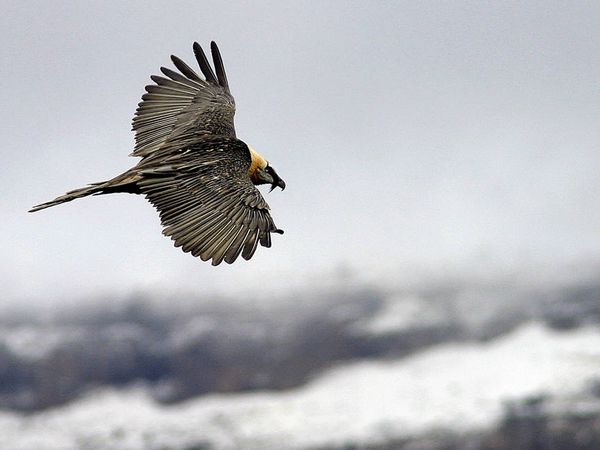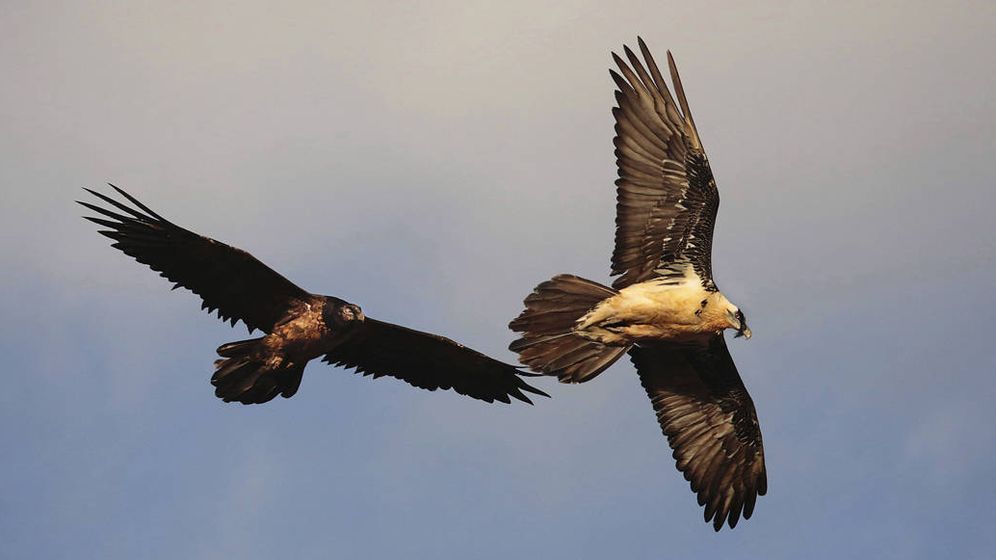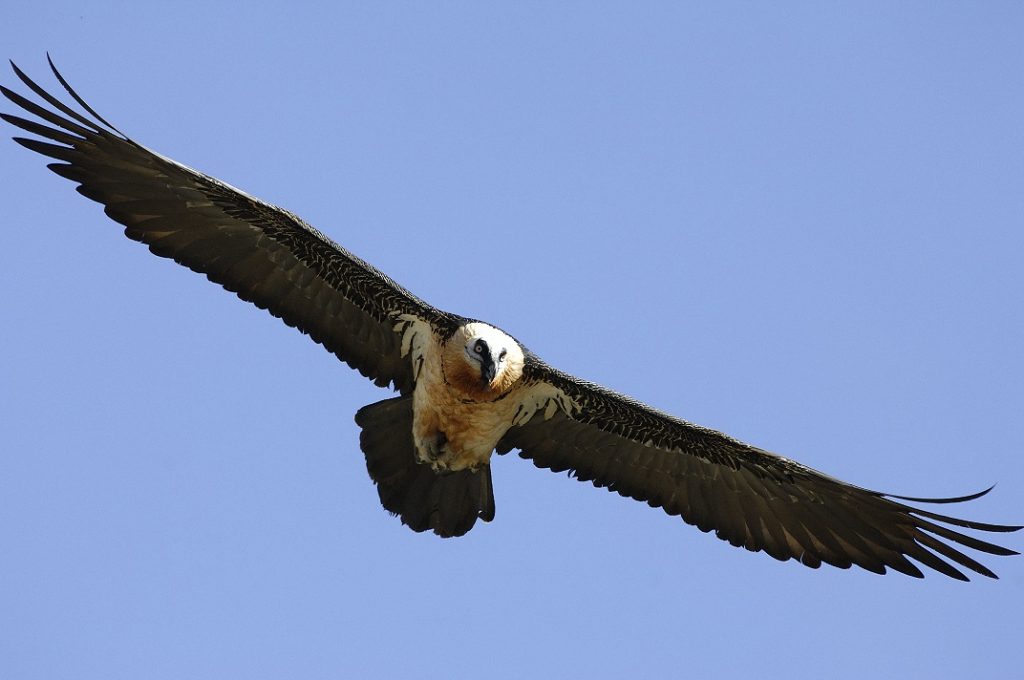Resume of the situation of the bearded vulture according to the article by Luis Lorente “Sierra de Guara: bearded vulture with a human seal” (Source https://www.revistaquercus.es/noticia/3538/articulos/sierra-de-guara:-quebrantahuesos-con-sello-humano.html ) and the recent article written by Sarah Romer “The bearded vulture goes from 30 specimens to more than 1,000 in Spain” (Source https://www.elconfidencial.com/medioambiente/naturaleza/2021-12-17/quebrantahuesos-espana-peligro-extincion_3342403 / )

Sierra de Guara: bearded vulture with a human stamp
The ancestral influence between men and vultures is evident in the bearded vulture population of Sierra de Guara, south of the Aragonese Pyrenees. Being the most densely documented to date, it depends heavily on livestock remains, including those deposited in troughs. Another peculiarity is the strong competition with the griffon vulture, which can arise to its productivity.
The presence of bearded vultures (Gypaetus barbatus) in the Sierra de Guara (Huesca), in the south of the Pyrenees, has been permanent.
There is a old testimonial saying that an adult bearded vulture was killed due to disappearance in the Somontano region in 1932. In 1961 an adult specimen was observed near Nueno by Adolfo Aragües. According to this Aragonese ornithologist, during the 1960s pairs of bearded vultures from Nueno and the Vadiello reservoir were known in the Sierra de Guara and its surroundings. But the most famous, all sober among the foreigners who came to visit it, was located in the Mallos de Riglos.
In the mid-1980s eight occupied territories were already known in the whole of the Sierras Exteriors Pirenaicas. Five of them were in Sierra de Guara, between the Isuela and Vero rivers, scattered along the escarpments of the riverbeds and the most outstanding gorges and canyons of the sierra de Guara. Since 1986, the number of breeding units (pairs and trios) remained unchanged until the early 1990s, when a new one was established around the Formiga River, favored by one of the first feeders to be put into operation in the Pyrenees.
One of the promoters of this feeder was the naturalist David Gómez Samitier, who since the 1980s has helped locate new pairs in the mountains and participated in the filming of “The Bone-breaker’s Mountain” in 1987 by Richard and Julia Kemp. Many scenes of the species are filmed in Sierra Guara appear in this documentary. Those of a nest in the Balcés ravine and other spectacular ones in which the breaking of bones in breakwaters are documented.
In 1995, another reproductive unit was incorporated, this time on the northern slope of the mountain range. Since then, the new pairs settled near other existing territories –Vadiello, Formiga and Balcés– until 2006, the year in which the last settlement was recorded, formed by a trio that has not yet reproduced.

The bearded vulture goes from 30 copies to more than 1,000 in Spain
The bearded vulture (‘Gypaetus barbatus’) is an impressive scavenger bird. Unmistakable, with its nearly three meter wingspan. His silhouette flying through the Pyrenees is one of the most iconic in Spanish nature. The thin, dark wings taper into its body, while the tail is long and wedge-shaped. The body, legs and head are a dirty white, although they are deliberately stained dark orange using iron oxides found in calcareous rock when available. This animal is unique in taking advantage of carrion, consuming tendons, bones… fragmenting each piece by dropping it from a great height onto the rocks. It has always been a survival creature, adapted to living in very harsh environments in the mountains.
And we almost lost it. The direct and indirect persecution (hunting, poisons, collecting, collision of power lines or electrocution) to which the species was subjected caused the extinction or near extinction of most of the mountain massifs, finally confining it in the 20th century to some massifs of Pyrenees (Spain and France), Corsica, Greece and the Balkans. It is a bird that only lives in high mountainous areas, generally between 500 and 4,000 meters, so they have a very closed habitat. Bearded vultures breed worse and worse and there is more reproductive failure, which can cause a new decline in the species. It was a direct victim of the persecution against large carnivores, as happened with our precious Iberian lynx (a tandem of fear and ignorance) , that from less than a hundred specimens distributed between the Sierra de Andújar and Doñana, we have gone on to exceed 1,000. In Andalusia, the last specimen of bearded vulture disappeared in 1986. And, although it has never represented a threat to human activities in itself, it has been a collateral victim of practices such as the placement of poisoned baits against wolves or bears, as well as the deterioration of its habitat.
The most endangered scavenger species in Europe
Fortunately, the case of the bearded vulture has become similar to that of the Iberian lynx. It is in a state of recovery, going from just 30 individuals in the entire territory to more than 1,000 in our country. This was described in a study by the Institute for Research in Hunting Resources (IREC)-CSIC that estimated, for the first time, the total population of this species in danger of extinction with a method in which wandering specimens are reflected. There are 64% more than those accounted for so far. The population of the vulture in the Pyrenees is between 937 and 1,119 individuals, of which 36% are breeding pairs, which are settled in territories. This bird of prey belonging to the group of vultures is recovering little by little thanks, among other things, to the efforts of the Bearded Vulture Conservation Foundation (FCQ), a non-governmental organization dedicated to promoting and developing reintroduction projects and conservation in the mountain habitats where the bearded vulture lives.
Thanks to their work, and through dangerous climbing expeditions in the Pyrenees, they rescued around fifty eggs with little chance of surviving in the nest; they raised the chicks on a diet of bones from when they weighed only a few grams, and taught them the habits of their kind. Eventually, they reintroduced them into the wild, thus avoiding the threat of extinction. This was the beginning of his recovery. However, experts comment that bearded vultures breed worse and worse and there is more reproductive failure, which can cause a new decline in the species. But for now, the future is bright and there are plans to expand its territory.
The actual situation
In the last decade, various conservation projects have managed to recover ground, such as the finding of bearded vulture nests in the south of the Pyrenees. They are also present in the Sierra de Moncayo (Aragón), as well as at least five pairs in the Sierra de Cazorla de Jaén (Andalusia) and even the Picos de Europa, where there were no specimens (all of them, those released in Picos de Europa, are controlled by GPS to know exactly where they are moving and act in case of problems).

25 years later, the efforts of the Bearded Vulture Foundation have not only allowed us to see its fruits in the form of more than 1,000 specimens flying through Spain, but also, in this same 2021, we have witnessed the first birth of a bearded vulture in freedom in the National Park of the Picos de Europa, where the original population had become extinct more than 50 years earlier. The female was born on March 14 and was baptized with a very symbolic name: Welcome. The objective, from here, is to consolidate the populations of Picos de Europa, Cazorla and the Pyrenees and connect them together with the Sierra de Gredos (Ávila), where they will begin with the reintroduction of specimens very soon, in 2022.
If you are interested by birds and biodiversity you can clic here to see our Birdwatching activities and list of birds in Sierra de Guara

